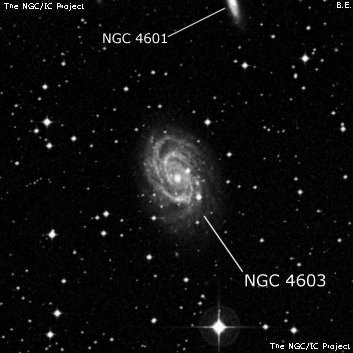
John Herschel discovered NGC 4603 = h3406 on 8 Jun 1834 and recorded "F; L R; vgbM; r(?). The following of 2 [with NGC 4601].". His RA is 11 sec east of ESO 322-052 = PGC 42510, a similar error as NGC 4601.
Pietro Baracchi observed this galaxy on 8 Apr 1885 with the Melbourne telesocpe and recorded "very faint, pretty large, irregular, glbM, mottled, roundish. A *15 mag attached to n.p. side or involved with the nebula - yes, just within it. Another star 15 mag s.p. very close to the edge of thenebula. Contour uncertain - seems to spread out but can't be traced by the eye."
400/500mm - 17.5" (4/7/89): extremely faint, moderately large, round, very low surface brightness. Member of the Centaurus cluster (AGC 3526).
600/800mm - 24" (4/12/08 - Magellan Observatory, Australia): at 200x appeared very bright, very large, elongated 2:1 SSW-NNE, 3'x1.5', broad concentration though the brightest portion seems offset towards the a star embedded just west of of the core. A second superimposed star is near the southwest end. NGC 4601 lies 5.3' NNW and NGC 4603B is 7.8' SW. This subgroup of AGC 3526 (Centaurus Cluster) is catalogued as Klemola 19.
Notes by Steve Gottlieb